International Business Negotiation - June 2018: Report Analysis
VerifiedAdded on 2023/06/10
|15
|4376
|100
Report
AI Summary
This report provides a detailed overview of international business negotiation. It begins by defining negotiation and its significance in both daily life and international business contexts. The report then outlines the stages of negotiation, including pre-negotiation, conceptualization, detailing, and follow-up. It explores key negotiation tools such as BATNA (Best Alternative to a Negotiated Agreement) and EATNA (Estimated Alternatives to a Negotiated Agreement), emphasizing their roles in determining negotiation outcomes. The linkage theory is also discussed, highlighting the influence of the negotiation environment on outcomes. Furthermore, the report touches upon cross-cultural negotiation, acknowledging the importance of adapting negotiation strategies to different cultural contexts, and it concludes by summarizing the key takeaways and the importance of effective negotiation in international business.

Running Head: INTERNATIONAL BUSINESS NEGOTIATION
International business negotiation
June 20
2018
Negotiation in
different aspects and
tools used for
negotiation
International business negotiation
June 20
2018
Negotiation in
different aspects and
tools used for
negotiation
Paraphrase This Document
Need a fresh take? Get an instant paraphrase of this document with our AI Paraphraser
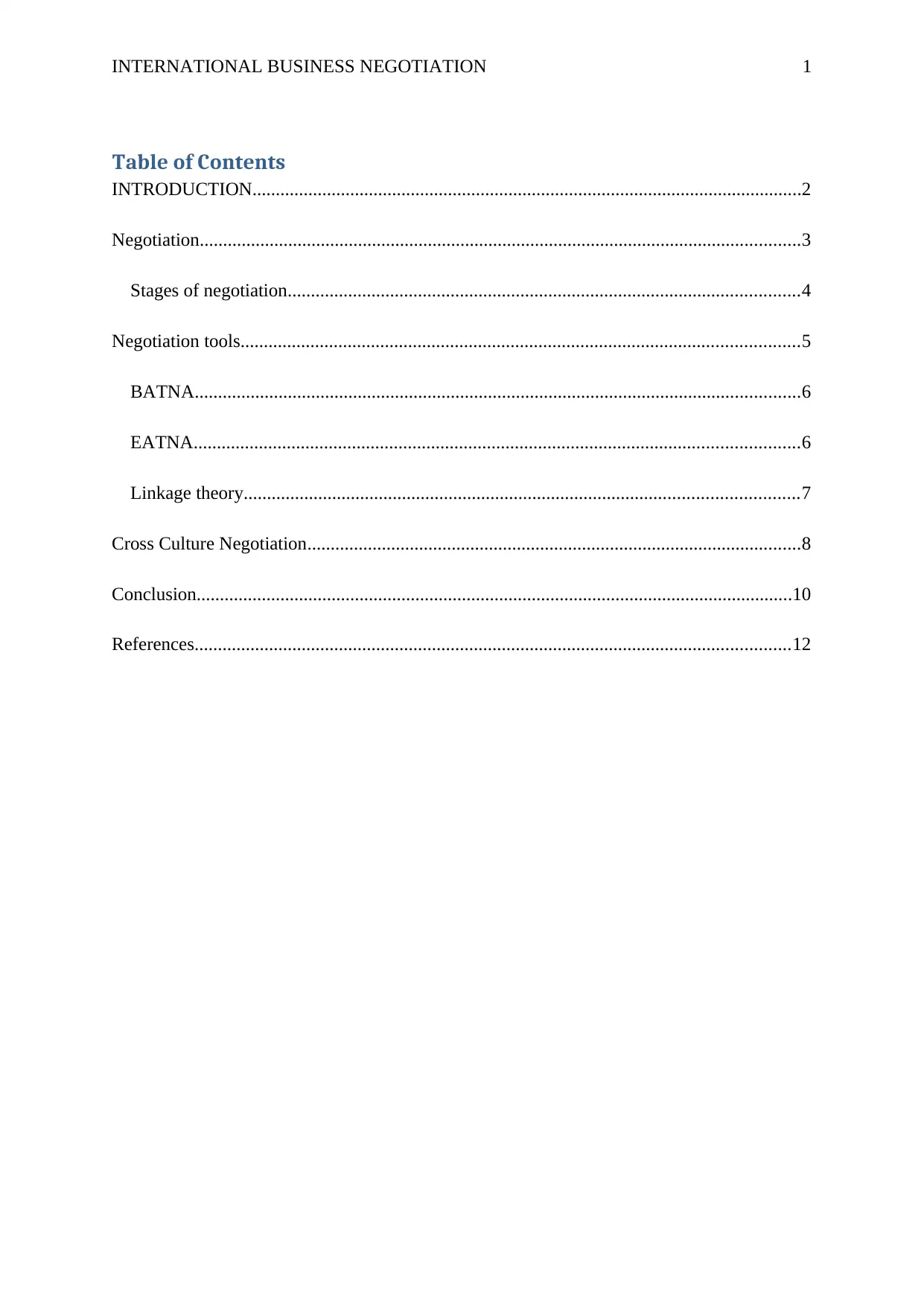
INTERNATIONAL BUSINESS NEGOTIATION 1
Table of Contents
INTRODUCTION......................................................................................................................2
Negotiation.................................................................................................................................3
Stages of negotiation..............................................................................................................4
Negotiation tools........................................................................................................................5
BATNA..................................................................................................................................6
EATNA..................................................................................................................................6
Linkage theory.......................................................................................................................7
Cross Culture Negotiation..........................................................................................................8
Conclusion................................................................................................................................10
References................................................................................................................................12
Table of Contents
INTRODUCTION......................................................................................................................2
Negotiation.................................................................................................................................3
Stages of negotiation..............................................................................................................4
Negotiation tools........................................................................................................................5
BATNA..................................................................................................................................6
EATNA..................................................................................................................................6
Linkage theory.......................................................................................................................7
Cross Culture Negotiation..........................................................................................................8
Conclusion................................................................................................................................10
References................................................................................................................................12
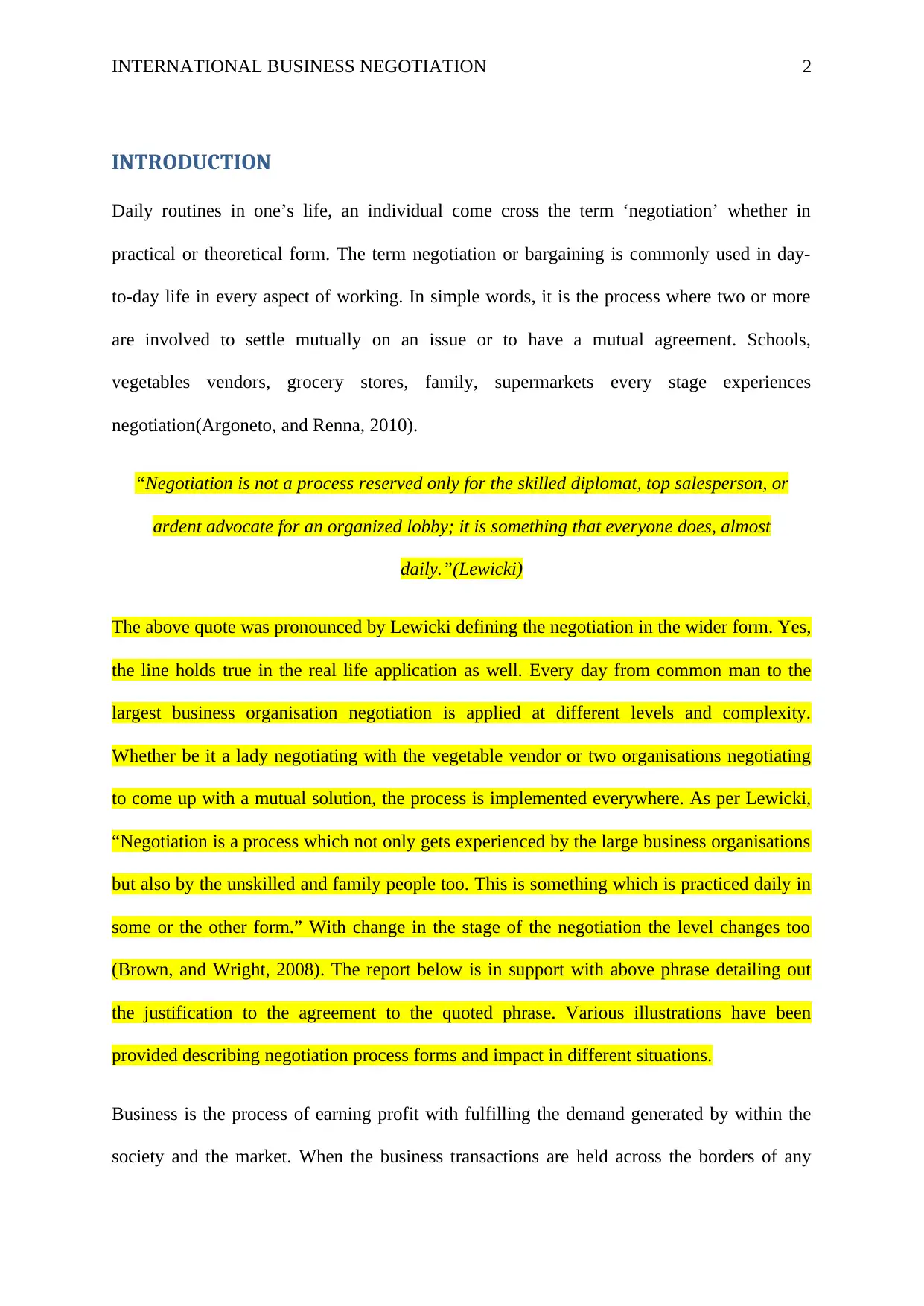
INTERNATIONAL BUSINESS NEGOTIATION 2
INTRODUCTION
Daily routines in one’s life, an individual come cross the term ‘negotiation’ whether in
practical or theoretical form. The term negotiation or bargaining is commonly used in day-
to-day life in every aspect of working. In simple words, it is the process where two or more
are involved to settle mutually on an issue or to have a mutual agreement. Schools,
vegetables vendors, grocery stores, family, supermarkets every stage experiences
negotiation(Argoneto, and Renna, 2010).
“Negotiation is not a process reserved only for the skilled diplomat, top salesperson, or
ardent advocate for an organized lobby; it is something that everyone does, almost
daily.”(Lewicki)
The above quote was pronounced by Lewicki defining the negotiation in the wider form. Yes,
the line holds true in the real life application as well. Every day from common man to the
largest business organisation negotiation is applied at different levels and complexity.
Whether be it a lady negotiating with the vegetable vendor or two organisations negotiating
to come up with a mutual solution, the process is implemented everywhere. As per Lewicki,
“Negotiation is a process which not only gets experienced by the large business organisations
but also by the unskilled and family people too. This is something which is practiced daily in
some or the other form.” With change in the stage of the negotiation the level changes too
(Brown, and Wright, 2008). The report below is in support with above phrase detailing out
the justification to the agreement to the quoted phrase. Various illustrations have been
provided describing negotiation process forms and impact in different situations.
Business is the process of earning profit with fulfilling the demand generated by within the
society and the market. When the business transactions are held across the borders of any
INTRODUCTION
Daily routines in one’s life, an individual come cross the term ‘negotiation’ whether in
practical or theoretical form. The term negotiation or bargaining is commonly used in day-
to-day life in every aspect of working. In simple words, it is the process where two or more
are involved to settle mutually on an issue or to have a mutual agreement. Schools,
vegetables vendors, grocery stores, family, supermarkets every stage experiences
negotiation(Argoneto, and Renna, 2010).
“Negotiation is not a process reserved only for the skilled diplomat, top salesperson, or
ardent advocate for an organized lobby; it is something that everyone does, almost
daily.”(Lewicki)
The above quote was pronounced by Lewicki defining the negotiation in the wider form. Yes,
the line holds true in the real life application as well. Every day from common man to the
largest business organisation negotiation is applied at different levels and complexity.
Whether be it a lady negotiating with the vegetable vendor or two organisations negotiating
to come up with a mutual solution, the process is implemented everywhere. As per Lewicki,
“Negotiation is a process which not only gets experienced by the large business organisations
but also by the unskilled and family people too. This is something which is practiced daily in
some or the other form.” With change in the stage of the negotiation the level changes too
(Brown, and Wright, 2008). The report below is in support with above phrase detailing out
the justification to the agreement to the quoted phrase. Various illustrations have been
provided describing negotiation process forms and impact in different situations.
Business is the process of earning profit with fulfilling the demand generated by within the
society and the market. When the business transactions are held across the borders of any
⊘ This is a preview!⊘
Do you want full access?
Subscribe today to unlock all pages.

Trusted by 1+ million students worldwide

INTERNATIONAL BUSINESS NEGOTIATION 3
country it is termed as International business. In the given content below, the different aspects
of negotiations on different levels are being focused on. From day-to-day routine work to the
international business tractions the simplicity till complexity will be highlighted. Negotiation
is something which is simple and complex at the same time. It consists of various stages to
reach out the final negotiated outcome. When individuals mutually come to an agreement
they consider many alternatives to choose the appropriate outcome.
Negotiation
Negotiation has been the subject matter for many researchers in the recent time. Negotiation
is not the process followed only by professionals, experts, and salespersons. Today, in day to
day life everyone negotiate with someone in some context of daily routine tasks. Before the
process of negotiation is discussed it is very important to understand that what does the term
negotiation means in actual. Basic meaning of negotiation can be defined as it is the process
of communication that takes place for general objectives everyone has to accomplish in their
daily life (Miller, 2014). In this process the communication of different parties shows their
individual opinions or thoughts to make a common understanding between parties taking
parties in such communications (Elfenbein, 2014).Such general or common objectives
accomplished in negotiations are mutual for their sustainability. In the process of negotiation,
each party or side of the communication represent their interests in their own perspective to
make influence the mutual objective influenced by their interests.
According to Chaturvedi (2011), when two or more people or parties engaged in a
communicationto find amutual solution of the issues they are facing is defined as negotiation.
Although different tools like compromise and concession are used in the process, an
agreement is made necessarily to be committed to the mutual decision made by the whole
process of negotiation (Rolland, 2010). Sometimes at the place where negotiation does not
country it is termed as International business. In the given content below, the different aspects
of negotiations on different levels are being focused on. From day-to-day routine work to the
international business tractions the simplicity till complexity will be highlighted. Negotiation
is something which is simple and complex at the same time. It consists of various stages to
reach out the final negotiated outcome. When individuals mutually come to an agreement
they consider many alternatives to choose the appropriate outcome.
Negotiation
Negotiation has been the subject matter for many researchers in the recent time. Negotiation
is not the process followed only by professionals, experts, and salespersons. Today, in day to
day life everyone negotiate with someone in some context of daily routine tasks. Before the
process of negotiation is discussed it is very important to understand that what does the term
negotiation means in actual. Basic meaning of negotiation can be defined as it is the process
of communication that takes place for general objectives everyone has to accomplish in their
daily life (Miller, 2014). In this process the communication of different parties shows their
individual opinions or thoughts to make a common understanding between parties taking
parties in such communications (Elfenbein, 2014).Such general or common objectives
accomplished in negotiations are mutual for their sustainability. In the process of negotiation,
each party or side of the communication represent their interests in their own perspective to
make influence the mutual objective influenced by their interests.
According to Chaturvedi (2011), when two or more people or parties engaged in a
communicationto find amutual solution of the issues they are facing is defined as negotiation.
Although different tools like compromise and concession are used in the process, an
agreement is made necessarily to be committed to the mutual decision made by the whole
process of negotiation (Rolland, 2010). Sometimes at the place where negotiation does not
Paraphrase This Document
Need a fresh take? Get an instant paraphrase of this document with our AI Paraphraser
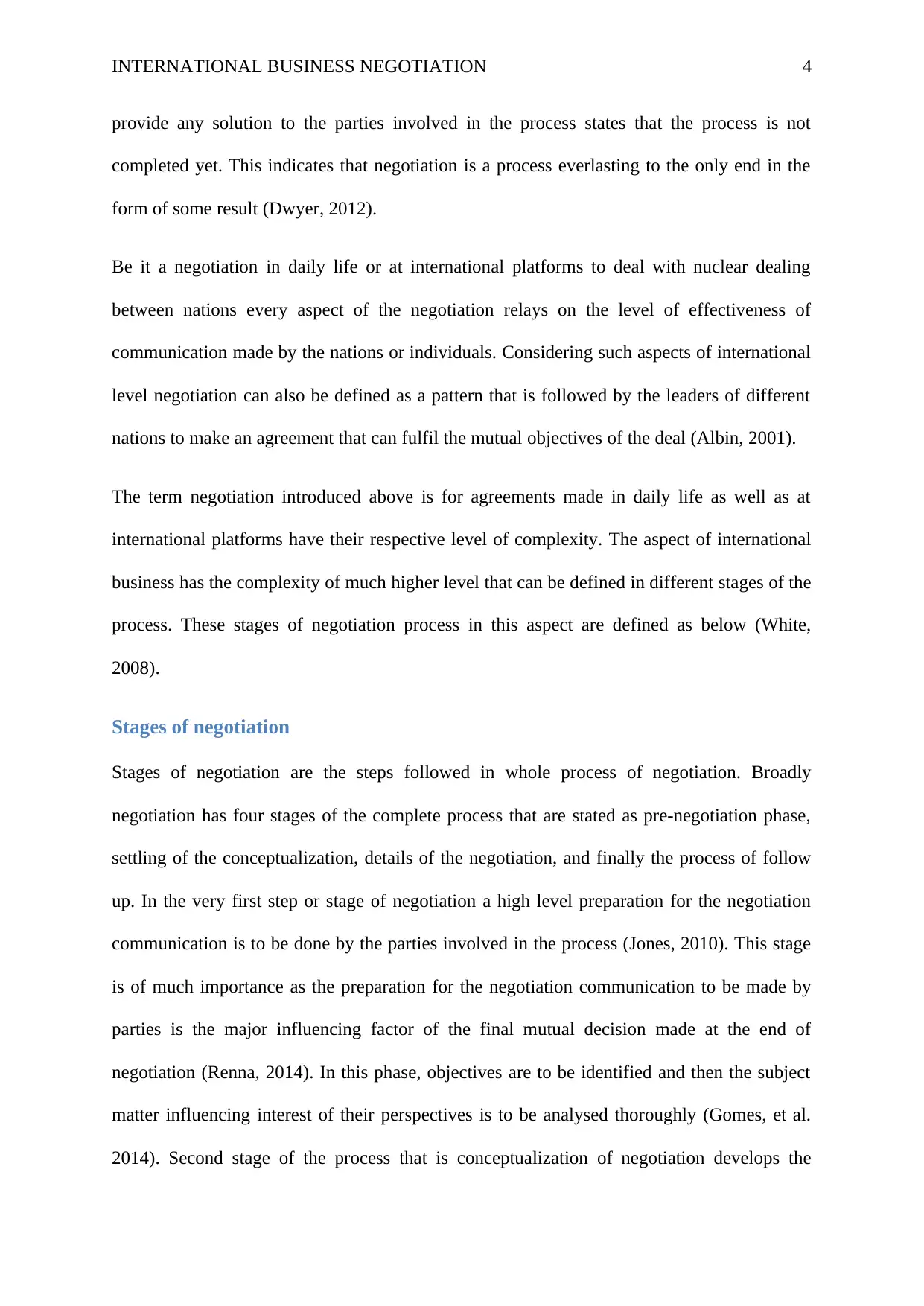
INTERNATIONAL BUSINESS NEGOTIATION 4
provide any solution to the parties involved in the process states that the process is not
completed yet. This indicates that negotiation is a process everlasting to the only end in the
form of some result (Dwyer, 2012).
Be it a negotiation in daily life or at international platforms to deal with nuclear dealing
between nations every aspect of the negotiation relays on the level of effectiveness of
communication made by the nations or individuals. Considering such aspects of international
level negotiation can also be defined as a pattern that is followed by the leaders of different
nations to make an agreement that can fulfil the mutual objectives of the deal (Albin, 2001).
The term negotiation introduced above is for agreements made in daily life as well as at
international platforms have their respective level of complexity. The aspect of international
business has the complexity of much higher level that can be defined in different stages of the
process. These stages of negotiation process in this aspect are defined as below (White,
2008).
Stages of negotiation
Stages of negotiation are the steps followed in whole process of negotiation. Broadly
negotiation has four stages of the complete process that are stated as pre-negotiation phase,
settling of the conceptualization, details of the negotiation, and finally the process of follow
up. In the very first step or stage of negotiation a high level preparation for the negotiation
communication is to be done by the parties involved in the process (Jones, 2010). This stage
is of much importance as the preparation for the negotiation communication to be made by
parties is the major influencing factor of the final mutual decision made at the end of
negotiation (Renna, 2014). In this phase, objectives are to be identified and then the subject
matter influencing interest of their perspectives is to be analysed thoroughly (Gomes, et al.
2014). Second stage of the process that is conceptualization of negotiation develops the
provide any solution to the parties involved in the process states that the process is not
completed yet. This indicates that negotiation is a process everlasting to the only end in the
form of some result (Dwyer, 2012).
Be it a negotiation in daily life or at international platforms to deal with nuclear dealing
between nations every aspect of the negotiation relays on the level of effectiveness of
communication made by the nations or individuals. Considering such aspects of international
level negotiation can also be defined as a pattern that is followed by the leaders of different
nations to make an agreement that can fulfil the mutual objectives of the deal (Albin, 2001).
The term negotiation introduced above is for agreements made in daily life as well as at
international platforms have their respective level of complexity. The aspect of international
business has the complexity of much higher level that can be defined in different stages of the
process. These stages of negotiation process in this aspect are defined as below (White,
2008).
Stages of negotiation
Stages of negotiation are the steps followed in whole process of negotiation. Broadly
negotiation has four stages of the complete process that are stated as pre-negotiation phase,
settling of the conceptualization, details of the negotiation, and finally the process of follow
up. In the very first step or stage of negotiation a high level preparation for the negotiation
communication is to be done by the parties involved in the process (Jones, 2010). This stage
is of much importance as the preparation for the negotiation communication to be made by
parties is the major influencing factor of the final mutual decision made at the end of
negotiation (Renna, 2014). In this phase, objectives are to be identified and then the subject
matter influencing interest of their perspectives is to be analysed thoroughly (Gomes, et al.
2014). Second stage of the process that is conceptualization of negotiation develops the
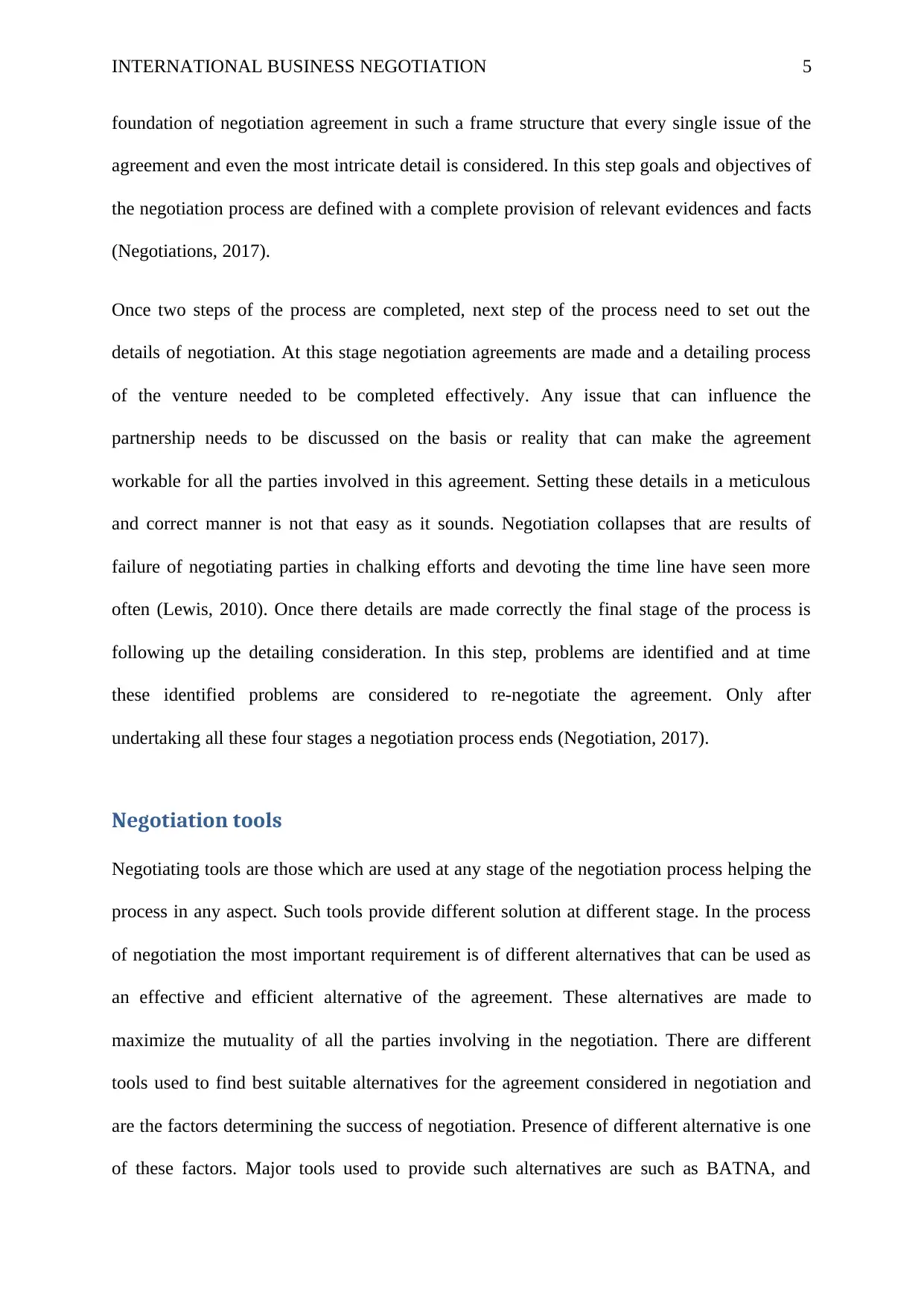
INTERNATIONAL BUSINESS NEGOTIATION 5
foundation of negotiation agreement in such a frame structure that every single issue of the
agreement and even the most intricate detail is considered. In this step goals and objectives of
the negotiation process are defined with a complete provision of relevant evidences and facts
(Negotiations, 2017).
Once two steps of the process are completed, next step of the process need to set out the
details of negotiation. At this stage negotiation agreements are made and a detailing process
of the venture needed to be completed effectively. Any issue that can influence the
partnership needs to be discussed on the basis or reality that can make the agreement
workable for all the parties involved in this agreement. Setting these details in a meticulous
and correct manner is not that easy as it sounds. Negotiation collapses that are results of
failure of negotiating parties in chalking efforts and devoting the time line have seen more
often (Lewis, 2010). Once there details are made correctly the final stage of the process is
following up the detailing consideration. In this step, problems are identified and at time
these identified problems are considered to re-negotiate the agreement. Only after
undertaking all these four stages a negotiation process ends (Negotiation, 2017).
Negotiation tools
Negotiating tools are those which are used at any stage of the negotiation process helping the
process in any aspect. Such tools provide different solution at different stage. In the process
of negotiation the most important requirement is of different alternatives that can be used as
an effective and efficient alternative of the agreement. These alternatives are made to
maximize the mutuality of all the parties involving in the negotiation. There are different
tools used to find best suitable alternatives for the agreement considered in negotiation and
are the factors determining the success of negotiation. Presence of different alternative is one
of these factors. Major tools used to provide such alternatives are such as BATNA, and
foundation of negotiation agreement in such a frame structure that every single issue of the
agreement and even the most intricate detail is considered. In this step goals and objectives of
the negotiation process are defined with a complete provision of relevant evidences and facts
(Negotiations, 2017).
Once two steps of the process are completed, next step of the process need to set out the
details of negotiation. At this stage negotiation agreements are made and a detailing process
of the venture needed to be completed effectively. Any issue that can influence the
partnership needs to be discussed on the basis or reality that can make the agreement
workable for all the parties involved in this agreement. Setting these details in a meticulous
and correct manner is not that easy as it sounds. Negotiation collapses that are results of
failure of negotiating parties in chalking efforts and devoting the time line have seen more
often (Lewis, 2010). Once there details are made correctly the final stage of the process is
following up the detailing consideration. In this step, problems are identified and at time
these identified problems are considered to re-negotiate the agreement. Only after
undertaking all these four stages a negotiation process ends (Negotiation, 2017).
Negotiation tools
Negotiating tools are those which are used at any stage of the negotiation process helping the
process in any aspect. Such tools provide different solution at different stage. In the process
of negotiation the most important requirement is of different alternatives that can be used as
an effective and efficient alternative of the agreement. These alternatives are made to
maximize the mutuality of all the parties involving in the negotiation. There are different
tools used to find best suitable alternatives for the agreement considered in negotiation and
are the factors determining the success of negotiation. Presence of different alternative is one
of these factors. Major tools used to provide such alternatives are such as BATNA, and
⊘ This is a preview!⊘
Do you want full access?
Subscribe today to unlock all pages.

Trusted by 1+ million students worldwide
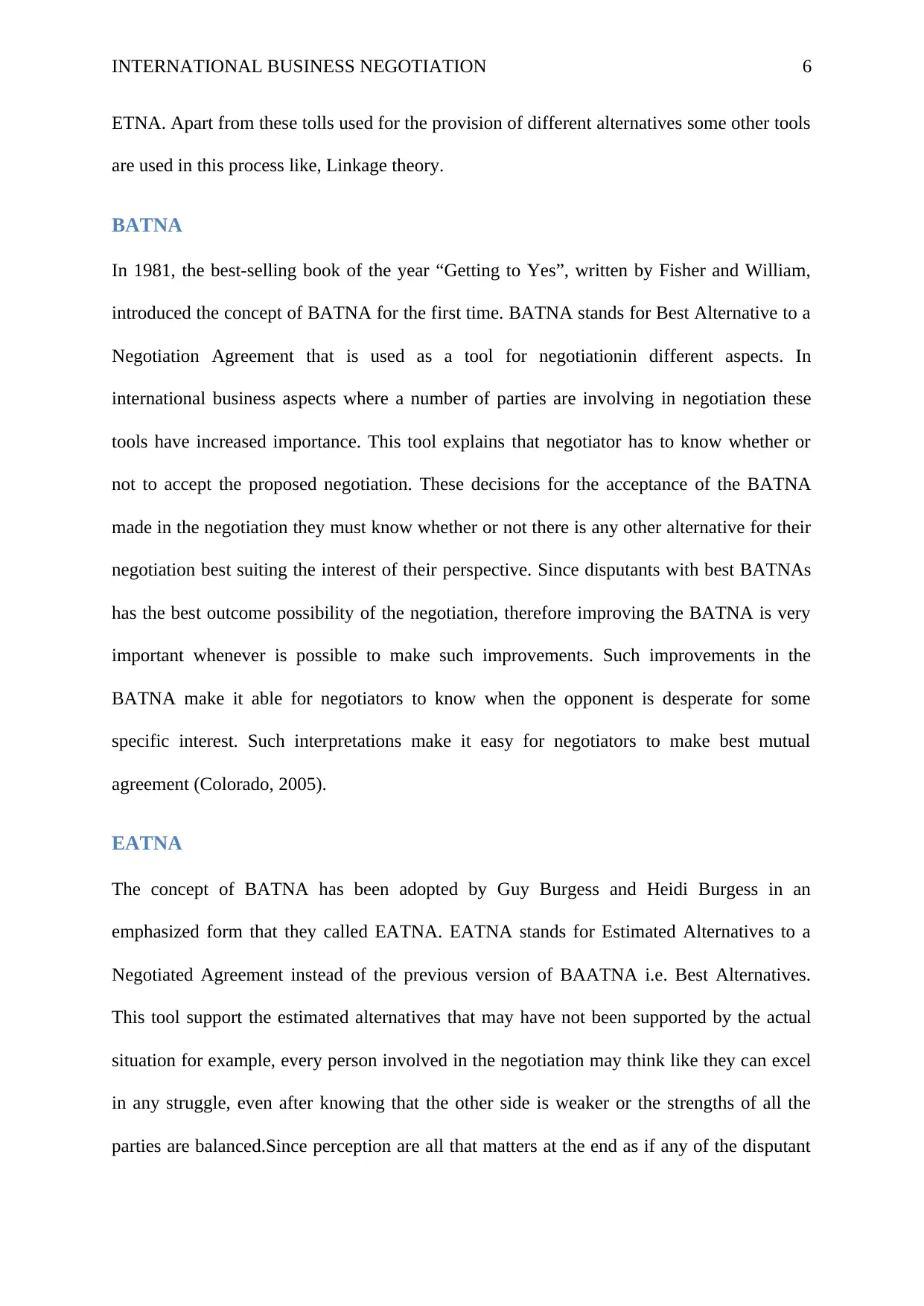
INTERNATIONAL BUSINESS NEGOTIATION 6
ETNA. Apart from these tolls used for the provision of different alternatives some other tools
are used in this process like, Linkage theory.
BATNA
In 1981, the best-selling book of the year “Getting to Yes”, written by Fisher and William,
introduced the concept of BATNA for the first time. BATNA stands for Best Alternative to a
Negotiation Agreement that is used as a tool for negotiationin different aspects. In
international business aspects where a number of parties are involving in negotiation these
tools have increased importance. This tool explains that negotiator has to know whether or
not to accept the proposed negotiation. These decisions for the acceptance of the BATNA
made in the negotiation they must know whether or not there is any other alternative for their
negotiation best suiting the interest of their perspective. Since disputants with best BATNAs
has the best outcome possibility of the negotiation, therefore improving the BATNA is very
important whenever is possible to make such improvements. Such improvements in the
BATNA make it able for negotiators to know when the opponent is desperate for some
specific interest. Such interpretations make it easy for negotiators to make best mutual
agreement (Colorado, 2005).
EATNA
The concept of BATNA has been adopted by Guy Burgess and Heidi Burgess in an
emphasized form that they called EATNA. EATNA stands for Estimated Alternatives to a
Negotiated Agreement instead of the previous version of BAATNA i.e. Best Alternatives.
This tool support the estimated alternatives that may have not been supported by the actual
situation for example, every person involved in the negotiation may think like they can excel
in any struggle, even after knowing that the other side is weaker or the strengths of all the
parties are balanced.Since perception are all that matters at the end as if any of the disputant
ETNA. Apart from these tolls used for the provision of different alternatives some other tools
are used in this process like, Linkage theory.
BATNA
In 1981, the best-selling book of the year “Getting to Yes”, written by Fisher and William,
introduced the concept of BATNA for the first time. BATNA stands for Best Alternative to a
Negotiation Agreement that is used as a tool for negotiationin different aspects. In
international business aspects where a number of parties are involving in negotiation these
tools have increased importance. This tool explains that negotiator has to know whether or
not to accept the proposed negotiation. These decisions for the acceptance of the BATNA
made in the negotiation they must know whether or not there is any other alternative for their
negotiation best suiting the interest of their perspective. Since disputants with best BATNAs
has the best outcome possibility of the negotiation, therefore improving the BATNA is very
important whenever is possible to make such improvements. Such improvements in the
BATNA make it able for negotiators to know when the opponent is desperate for some
specific interest. Such interpretations make it easy for negotiators to make best mutual
agreement (Colorado, 2005).
EATNA
The concept of BATNA has been adopted by Guy Burgess and Heidi Burgess in an
emphasized form that they called EATNA. EATNA stands for Estimated Alternatives to a
Negotiated Agreement instead of the previous version of BAATNA i.e. Best Alternatives.
This tool support the estimated alternatives that may have not been supported by the actual
situation for example, every person involved in the negotiation may think like they can excel
in any struggle, even after knowing that the other side is weaker or the strengths of all the
parties are balanced.Since perception are all that matters at the end as if any of the disputant
Paraphrase This Document
Need a fresh take? Get an instant paraphrase of this document with our AI Paraphraser
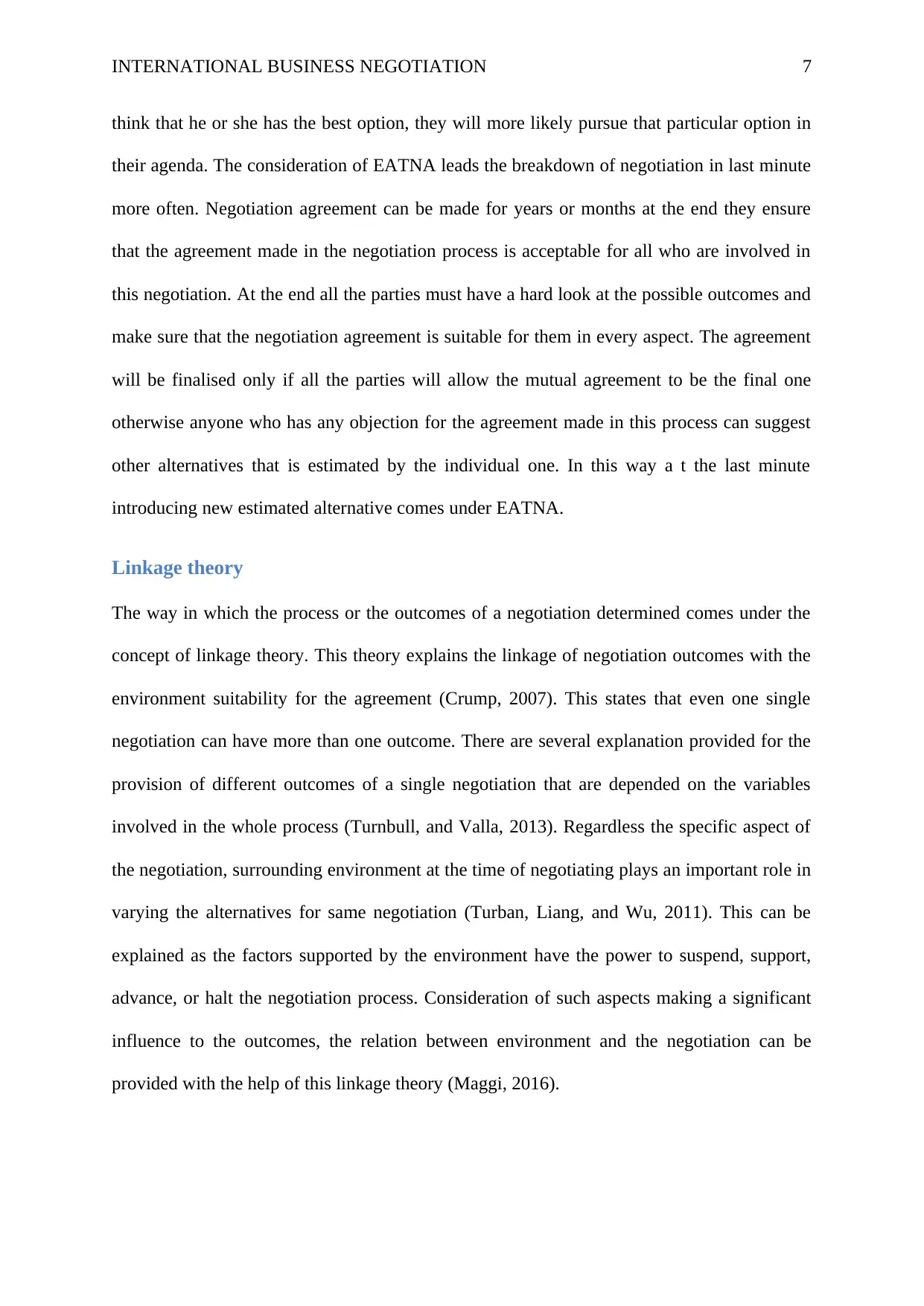
INTERNATIONAL BUSINESS NEGOTIATION 7
think that he or she has the best option, they will more likely pursue that particular option in
their agenda. The consideration of EATNA leads the breakdown of negotiation in last minute
more often. Negotiation agreement can be made for years or months at the end they ensure
that the agreement made in the negotiation process is acceptable for all who are involved in
this negotiation. At the end all the parties must have a hard look at the possible outcomes and
make sure that the negotiation agreement is suitable for them in every aspect. The agreement
will be finalised only if all the parties will allow the mutual agreement to be the final one
otherwise anyone who has any objection for the agreement made in this process can suggest
other alternatives that is estimated by the individual one. In this way a t the last minute
introducing new estimated alternative comes under EATNA.
Linkage theory
The way in which the process or the outcomes of a negotiation determined comes under the
concept of linkage theory. This theory explains the linkage of negotiation outcomes with the
environment suitability for the agreement (Crump, 2007). This states that even one single
negotiation can have more than one outcome. There are several explanation provided for the
provision of different outcomes of a single negotiation that are depended on the variables
involved in the whole process (Turnbull, and Valla, 2013). Regardless the specific aspect of
the negotiation, surrounding environment at the time of negotiating plays an important role in
varying the alternatives for same negotiation (Turban, Liang, and Wu, 2011). This can be
explained as the factors supported by the environment have the power to suspend, support,
advance, or halt the negotiation process. Consideration of such aspects making a significant
influence to the outcomes, the relation between environment and the negotiation can be
provided with the help of this linkage theory (Maggi, 2016).
think that he or she has the best option, they will more likely pursue that particular option in
their agenda. The consideration of EATNA leads the breakdown of negotiation in last minute
more often. Negotiation agreement can be made for years or months at the end they ensure
that the agreement made in the negotiation process is acceptable for all who are involved in
this negotiation. At the end all the parties must have a hard look at the possible outcomes and
make sure that the negotiation agreement is suitable for them in every aspect. The agreement
will be finalised only if all the parties will allow the mutual agreement to be the final one
otherwise anyone who has any objection for the agreement made in this process can suggest
other alternatives that is estimated by the individual one. In this way a t the last minute
introducing new estimated alternative comes under EATNA.
Linkage theory
The way in which the process or the outcomes of a negotiation determined comes under the
concept of linkage theory. This theory explains the linkage of negotiation outcomes with the
environment suitability for the agreement (Crump, 2007). This states that even one single
negotiation can have more than one outcome. There are several explanation provided for the
provision of different outcomes of a single negotiation that are depended on the variables
involved in the whole process (Turnbull, and Valla, 2013). Regardless the specific aspect of
the negotiation, surrounding environment at the time of negotiating plays an important role in
varying the alternatives for same negotiation (Turban, Liang, and Wu, 2011). This can be
explained as the factors supported by the environment have the power to suspend, support,
advance, or halt the negotiation process. Consideration of such aspects making a significant
influence to the outcomes, the relation between environment and the negotiation can be
provided with the help of this linkage theory (Maggi, 2016).
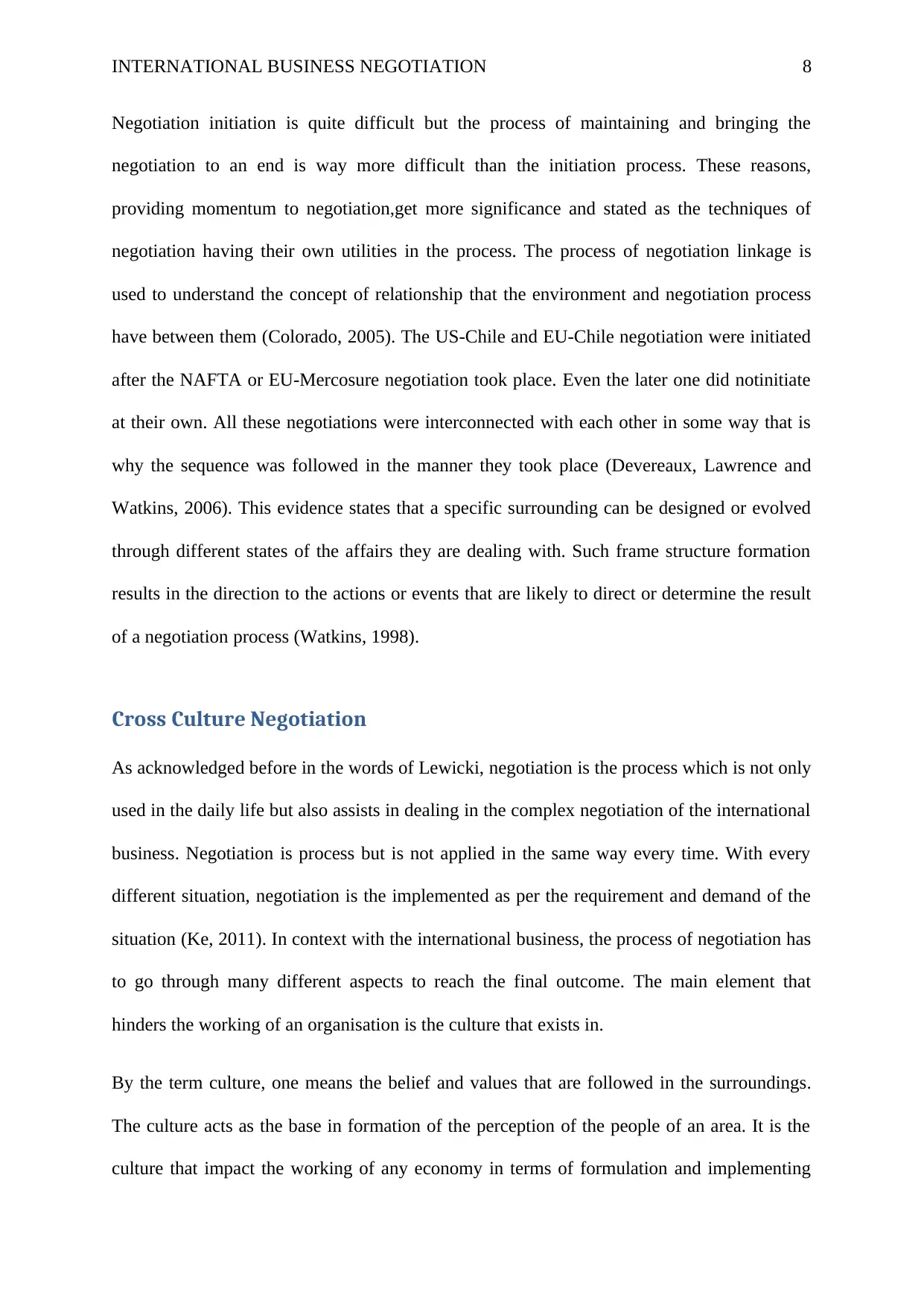
INTERNATIONAL BUSINESS NEGOTIATION 8
Negotiation initiation is quite difficult but the process of maintaining and bringing the
negotiation to an end is way more difficult than the initiation process. These reasons,
providing momentum to negotiation,get more significance and stated as the techniques of
negotiation having their own utilities in the process. The process of negotiation linkage is
used to understand the concept of relationship that the environment and negotiation process
have between them (Colorado, 2005). The US-Chile and EU-Chile negotiation were initiated
after the NAFTA or EU-Mercosure negotiation took place. Even the later one did notinitiate
at their own. All these negotiations were interconnected with each other in some way that is
why the sequence was followed in the manner they took place (Devereaux, Lawrence and
Watkins, 2006). This evidence states that a specific surrounding can be designed or evolved
through different states of the affairs they are dealing with. Such frame structure formation
results in the direction to the actions or events that are likely to direct or determine the result
of a negotiation process (Watkins, 1998).
Cross Culture Negotiation
As acknowledged before in the words of Lewicki, negotiation is the process which is not only
used in the daily life but also assists in dealing in the complex negotiation of the international
business. Negotiation is process but is not applied in the same way every time. With every
different situation, negotiation is the implemented as per the requirement and demand of the
situation (Ke, 2011). In context with the international business, the process of negotiation has
to go through many different aspects to reach the final outcome. The main element that
hinders the working of an organisation is the culture that exists in.
By the term culture, one means the belief and values that are followed in the surroundings.
The culture acts as the base in formation of the perception of the people of an area. It is the
culture that impact the working of any economy in terms of formulation and implementing
Negotiation initiation is quite difficult but the process of maintaining and bringing the
negotiation to an end is way more difficult than the initiation process. These reasons,
providing momentum to negotiation,get more significance and stated as the techniques of
negotiation having their own utilities in the process. The process of negotiation linkage is
used to understand the concept of relationship that the environment and negotiation process
have between them (Colorado, 2005). The US-Chile and EU-Chile negotiation were initiated
after the NAFTA or EU-Mercosure negotiation took place. Even the later one did notinitiate
at their own. All these negotiations were interconnected with each other in some way that is
why the sequence was followed in the manner they took place (Devereaux, Lawrence and
Watkins, 2006). This evidence states that a specific surrounding can be designed or evolved
through different states of the affairs they are dealing with. Such frame structure formation
results in the direction to the actions or events that are likely to direct or determine the result
of a negotiation process (Watkins, 1998).
Cross Culture Negotiation
As acknowledged before in the words of Lewicki, negotiation is the process which is not only
used in the daily life but also assists in dealing in the complex negotiation of the international
business. Negotiation is process but is not applied in the same way every time. With every
different situation, negotiation is the implemented as per the requirement and demand of the
situation (Ke, 2011). In context with the international business, the process of negotiation has
to go through many different aspects to reach the final outcome. The main element that
hinders the working of an organisation is the culture that exists in.
By the term culture, one means the belief and values that are followed in the surroundings.
The culture acts as the base in formation of the perception of the people of an area. It is the
culture that impact the working of any economy in terms of formulation and implementing
⊘ This is a preview!⊘
Do you want full access?
Subscribe today to unlock all pages.

Trusted by 1+ million students worldwide
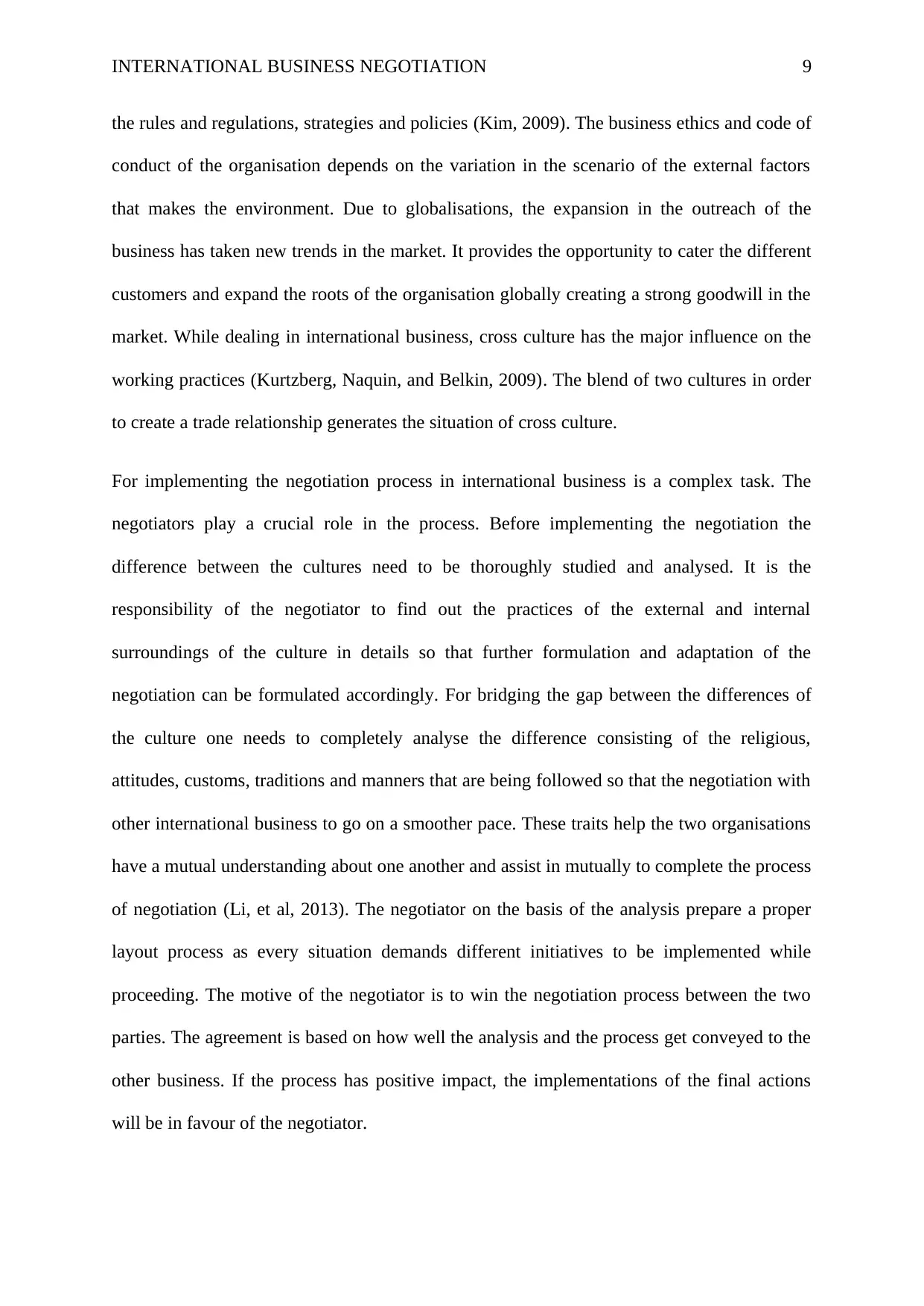
INTERNATIONAL BUSINESS NEGOTIATION 9
the rules and regulations, strategies and policies (Kim, 2009). The business ethics and code of
conduct of the organisation depends on the variation in the scenario of the external factors
that makes the environment. Due to globalisations, the expansion in the outreach of the
business has taken new trends in the market. It provides the opportunity to cater the different
customers and expand the roots of the organisation globally creating a strong goodwill in the
market. While dealing in international business, cross culture has the major influence on the
working practices (Kurtzberg, Naquin, and Belkin, 2009). The blend of two cultures in order
to create a trade relationship generates the situation of cross culture.
For implementing the negotiation process in international business is a complex task. The
negotiators play a crucial role in the process. Before implementing the negotiation the
difference between the cultures need to be thoroughly studied and analysed. It is the
responsibility of the negotiator to find out the practices of the external and internal
surroundings of the culture in details so that further formulation and adaptation of the
negotiation can be formulated accordingly. For bridging the gap between the differences of
the culture one needs to completely analyse the difference consisting of the religious,
attitudes, customs, traditions and manners that are being followed so that the negotiation with
other international business to go on a smoother pace. These traits help the two organisations
have a mutual understanding about one another and assist in mutually to complete the process
of negotiation (Li, et al, 2013). The negotiator on the basis of the analysis prepare a proper
layout process as every situation demands different initiatives to be implemented while
proceeding. The motive of the negotiator is to win the negotiation process between the two
parties. The agreement is based on how well the analysis and the process get conveyed to the
other business. If the process has positive impact, the implementations of the final actions
will be in favour of the negotiator.
the rules and regulations, strategies and policies (Kim, 2009). The business ethics and code of
conduct of the organisation depends on the variation in the scenario of the external factors
that makes the environment. Due to globalisations, the expansion in the outreach of the
business has taken new trends in the market. It provides the opportunity to cater the different
customers and expand the roots of the organisation globally creating a strong goodwill in the
market. While dealing in international business, cross culture has the major influence on the
working practices (Kurtzberg, Naquin, and Belkin, 2009). The blend of two cultures in order
to create a trade relationship generates the situation of cross culture.
For implementing the negotiation process in international business is a complex task. The
negotiators play a crucial role in the process. Before implementing the negotiation the
difference between the cultures need to be thoroughly studied and analysed. It is the
responsibility of the negotiator to find out the practices of the external and internal
surroundings of the culture in details so that further formulation and adaptation of the
negotiation can be formulated accordingly. For bridging the gap between the differences of
the culture one needs to completely analyse the difference consisting of the religious,
attitudes, customs, traditions and manners that are being followed so that the negotiation with
other international business to go on a smoother pace. These traits help the two organisations
have a mutual understanding about one another and assist in mutually to complete the process
of negotiation (Li, et al, 2013). The negotiator on the basis of the analysis prepare a proper
layout process as every situation demands different initiatives to be implemented while
proceeding. The motive of the negotiator is to win the negotiation process between the two
parties. The agreement is based on how well the analysis and the process get conveyed to the
other business. If the process has positive impact, the implementations of the final actions
will be in favour of the negotiator.
Paraphrase This Document
Need a fresh take? Get an instant paraphrase of this document with our AI Paraphraser

INTERNATIONAL BUSINESS NEGOTIATION 10
The concept of cross culture can be further elaborated by the following realistic illustration
that exists in the process of negotiation in real life situation. The people in the United States
and China have a vast cultural difference. The Chinese people have the custom of greeting
another individual by bowing down whereas the US people greet other individual by shaking
hands. The difference in the customs and belief can act as the hurdle that comes in the
between the two different country. For establishing a good relation the negotiator with the
aim of winning the process consider all the cultural factors to boost the impact and to create a
path towards the success of the negotiation (Yagi, and Kleinberg, 2011).
Hence, the culture plays an essential role in the successful implementation of the negotiation
process. To the negotiation process a favourable success the negotiator needs to be effective
in his role. The negotiation in the international business context, not only have a huge impact
on the current scenario but also have a future impact on the growth of the business. The
negotiation process is targeted with expansion of the business on the present and the future
aspects of the organisation. The external factors are one of those which need to be taken care
of as the business operates in the external surroundings and need to fulfil the requirements of
the market. In order to accomplish the target of the organisation in international market the
level of negotiation need to be with accordance to the terms and conditions of the
environment the organisation aims to cater (Zhang, and Zhou, 2009).
Conclusion
The term negotiation is something everyone comes across through daily. The process is used
every day between individuals to settle a conflict or issue to come up with a mutual solution
or outcome about the same. The content above shows the various applications of negotiation
from daily routine till the international business. From the concept and background of
negotiation it can be concluded that the world be on any level will practice the process to
The concept of cross culture can be further elaborated by the following realistic illustration
that exists in the process of negotiation in real life situation. The people in the United States
and China have a vast cultural difference. The Chinese people have the custom of greeting
another individual by bowing down whereas the US people greet other individual by shaking
hands. The difference in the customs and belief can act as the hurdle that comes in the
between the two different country. For establishing a good relation the negotiator with the
aim of winning the process consider all the cultural factors to boost the impact and to create a
path towards the success of the negotiation (Yagi, and Kleinberg, 2011).
Hence, the culture plays an essential role in the successful implementation of the negotiation
process. To the negotiation process a favourable success the negotiator needs to be effective
in his role. The negotiation in the international business context, not only have a huge impact
on the current scenario but also have a future impact on the growth of the business. The
negotiation process is targeted with expansion of the business on the present and the future
aspects of the organisation. The external factors are one of those which need to be taken care
of as the business operates in the external surroundings and need to fulfil the requirements of
the market. In order to accomplish the target of the organisation in international market the
level of negotiation need to be with accordance to the terms and conditions of the
environment the organisation aims to cater (Zhang, and Zhou, 2009).
Conclusion
The term negotiation is something everyone comes across through daily. The process is used
every day between individuals to settle a conflict or issue to come up with a mutual solution
or outcome about the same. The content above shows the various applications of negotiation
from daily routine till the international business. From the concept and background of
negotiation it can be concluded that the world be on any level will practice the process to
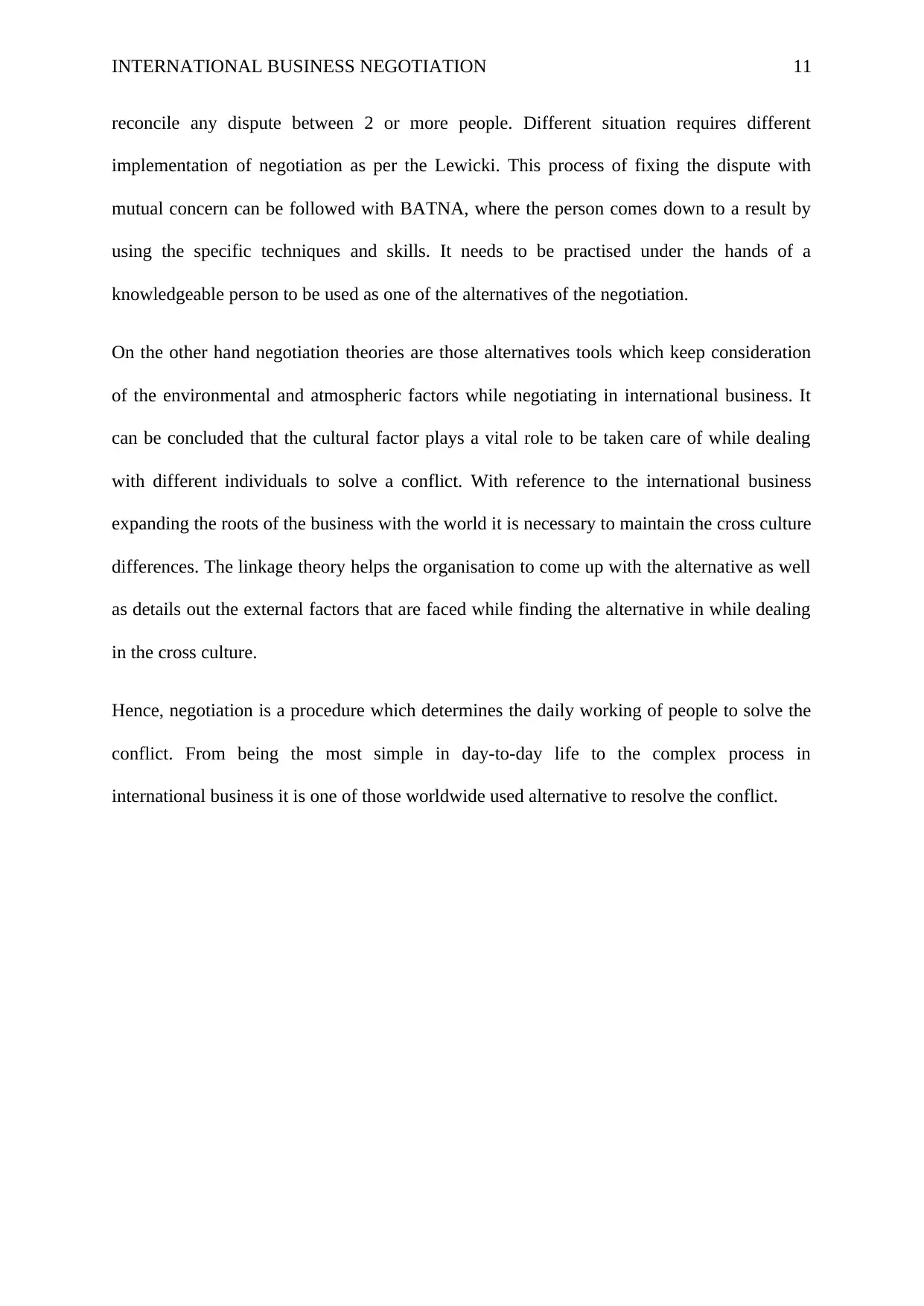
INTERNATIONAL BUSINESS NEGOTIATION 11
reconcile any dispute between 2 or more people. Different situation requires different
implementation of negotiation as per the Lewicki. This process of fixing the dispute with
mutual concern can be followed with BATNA, where the person comes down to a result by
using the specific techniques and skills. It needs to be practised under the hands of a
knowledgeable person to be used as one of the alternatives of the negotiation.
On the other hand negotiation theories are those alternatives tools which keep consideration
of the environmental and atmospheric factors while negotiating in international business. It
can be concluded that the cultural factor plays a vital role to be taken care of while dealing
with different individuals to solve a conflict. With reference to the international business
expanding the roots of the business with the world it is necessary to maintain the cross culture
differences. The linkage theory helps the organisation to come up with the alternative as well
as details out the external factors that are faced while finding the alternative in while dealing
in the cross culture.
Hence, negotiation is a procedure which determines the daily working of people to solve the
conflict. From being the most simple in day-to-day life to the complex process in
international business it is one of those worldwide used alternative to resolve the conflict.
reconcile any dispute between 2 or more people. Different situation requires different
implementation of negotiation as per the Lewicki. This process of fixing the dispute with
mutual concern can be followed with BATNA, where the person comes down to a result by
using the specific techniques and skills. It needs to be practised under the hands of a
knowledgeable person to be used as one of the alternatives of the negotiation.
On the other hand negotiation theories are those alternatives tools which keep consideration
of the environmental and atmospheric factors while negotiating in international business. It
can be concluded that the cultural factor plays a vital role to be taken care of while dealing
with different individuals to solve a conflict. With reference to the international business
expanding the roots of the business with the world it is necessary to maintain the cross culture
differences. The linkage theory helps the organisation to come up with the alternative as well
as details out the external factors that are faced while finding the alternative in while dealing
in the cross culture.
Hence, negotiation is a procedure which determines the daily working of people to solve the
conflict. From being the most simple in day-to-day life to the complex process in
international business it is one of those worldwide used alternative to resolve the conflict.
⊘ This is a preview!⊘
Do you want full access?
Subscribe today to unlock all pages.

Trusted by 1+ million students worldwide
1 out of 15
Related Documents
Your All-in-One AI-Powered Toolkit for Academic Success.
+13062052269
info@desklib.com
Available 24*7 on WhatsApp / Email
![[object Object]](/_next/static/media/star-bottom.7253800d.svg)
Unlock your academic potential
Copyright © 2020–2025 A2Z Services. All Rights Reserved. Developed and managed by ZUCOL.



